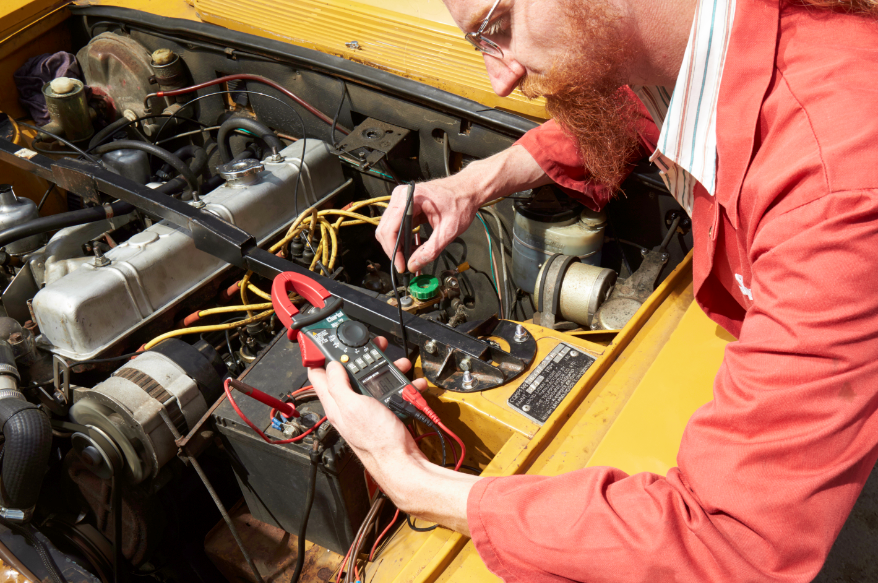On alternator-equipped cars, the ‘ignition light’ (more correctly described as the no-charge warning lamp) should extinguish as soon as the engine starts and shouldn’t be seen again. With a dynamo it’s quite normal for the light to glow at idle, though it should go out by about 1500rpm.
If your warning light is on, indicating no charge, you can start with two basic checks. Remove the warning light wire at the regulator box or back of the alternator. The light should go out. If it doesn’t, the fault’s in the warning light circuit – probably a chafed or trapped wire. If the light’s OK, check the voltage across the battery with a multimeter and the engine running. Less than 13.3V at mid-revs confirms there’s a charging problem.
Check the drive belt tension. Press your thumb hard into the middle of the longest run. It should ‘give’ by no more than 10-15mm. It shouldn’t be oily. Ensure it hasn’t worn to the extent that it’s sitting in the bottom of the pulley’s ‘V’ – it should sit at the top so it grips the sides.
Checking an alternator’s simple. Check that the unit’s earth by removing the tensioner strap and cleaning the contact areas on engine block and alternator. If that doesn’t cure the problem, remove the unit, unscrew the brush unit on the back and check that the carbon brushes are not stuck in their holder or worn down to little stumps. They should stick out by at least 4-5mm and be free to be pushed back on their springs. If the brushes are OK, the defect is probably in the regulator (usually part of the brush holder). If it’s a common make, you should be able to obtain a new regulator-and-brush unit for £5 to £10.
There’s a bit more to check with a dynamo. Again, start by making sure it’s earthing properly. Next, examine the bundle of wires that connects it to the regulator box. Check they’re all secure and the ends are free from corrosion and fraying. If the wires have spade connectors, examine these closely for dodgy crimping and looseness on the terminals.
If this fails, remove the dynamo, unscrew the end plate and examine the brushes. Again, make sure they’re free to move and aren’t unduly worn. If the brushes’ wire ends are screwed in place, make sure they’re clean and secure. If the innards are coated with carbon and grease, clean it with degreaser and a brush and, when dry, run very fine wet-and-dry paper around the copper commutator.
Finally, turn your attention to the regulator. This is a precision instrument and isn’t to be poked and prodded at random. However, it can go out of adjustment or fall victim to burning or corrosion of its internal contacts.
Adjustment isn’t likely to be the issue here, so examine the contacts. Gently move them to check they’re not stuck. Delicately pry them apart if they are. Run a little P1000 abrasive paper between the contacts to gently clean them, then blow the dust away. If you want to check the adjustment, you’ll have to find a service manual that covers that specific regulator. You can usually do a reasonable job with a set of feeler blades, a screwdriver, some needle-nose pliers and a voltmeter, though it requires care and patience.

I own 2007 Ford Bantam, as from end of 2017 its alternator is not charging until it was replaced with new one and also battery also replaced but still is not charging, if I took to the auto-electrician it will charge and the next morning is not charging or even stopped for afew hors it will not charge, what's the problem now.
A very useful bit of info,i will be saving this. Thanks
You might wish to tell the difference between alternator and generator/voltage regulator systems.
If you are telling people with limited knowledge about electrical systems it would be wise to get them to remove the Brown wire on the regulator to avoid touching the cut out contact and causing power to go directly to the dynamo, if they don't have a knowledge of low volt systems they may not realise that unless they prize open the cut out it could burn out the dynamo and damage the wiring.
I have a 200tdi defender, on tick over the no charge warning lamp just glows but the higher you rev the brighter it becomes. I will carry out the checks you have mentioned. Thanks.